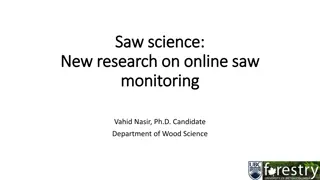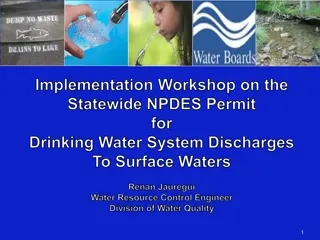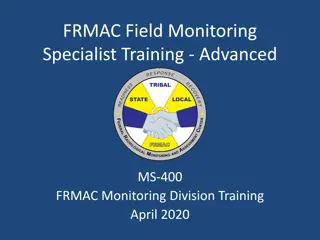Behavior Progress Monitoring for Individualized Instructional Planning
Utilizing behavior progress monitoring allows educators to track student performance over time, make data-informed decisions to improve responsiveness to interventions, and tailor instructional plans for individual students. This comprehensive approach involves steps such as setting the stage, analy
6 views • 52 slides
Insights into the National Monitoring on ESD in Germany
Dr. Antje Brock and Jorrit Holst, on behalf of the monitoring team, provide insights into the National Monitoring on ESD in Germany. The monitoring aims to capture the quantity and quality of ESD in formal and non-formal learning settings, offering instruments for evaluation and contributing to the
7 views • 10 slides
Weather Monitoring Systems Market
Weather Monitoring Systems Market by Component (Solutions, Services), Monitoring Type (Temperature Monitoring, Humidity Monitoring, Air Quality), End-use Industry (Agriculture, Aerospace), and Geography - Global Forecast to 2030\n
0 views • 4 slides
Weather Monitoring Systems Market
Weather Monitoring Systems Market by Component (Solutions, Services), Monitoring Type (Temperature Monitoring, Humidity Monitoring, Air Quality), End-use Industry (Agriculture, Aerospace), and Geography - Global Forecast to 2030\n
0 views • 4 slides
Weather Monitoring Systems Market
Weather Monitoring Systems Market by Component (Solutions, Services), Monitoring Type (Temperature Monitoring, Humidity Monitoring, Air Quality), End-use Industry (Agriculture, Aerospace), and Geography - Global Forecast to 2030\n
0 views • 4 slides
Abattoir Effluent Treatment: Understanding and Managing Waste Water in Meat Processing Plants
Effluents in abattoirs contain a variety of pollutants, including fats, oils, greases, chemicals, and organic matter. Direct discharge of untreated effluents can harm water bodies by depleting oxygen levels and disturbing pH balance. Terminologies like BOD and COD help measure the quality of wastewa
0 views • 13 slides
NIMH Clinical Research Education and Monitoring Program Overview
NIMH's Clinical Monitoring and Clinical Research Education, Support, and Training Program (CREST) aims to ensure the proper conduct, recording, and reporting of clinical trials. This program includes clinical monitoring plans, guidelines for site monitoring activities, and independent clinical monit
1 views • 29 slides
Challenges in Temba Drinking Water and Rooiwal Wastewater Treatment Works
The City of Tshwane's Water Services Authority faces significant challenges with the operation and quality of effluent at the Rooiwal Wastewater Treatment Works and the Temba Water Treatment Works. Issues include overcapacity, poor sludge management, non-compliant effluent, and inability to treat wa
0 views • 33 slides
Metamodel-based Photovoltaic Monitoring System for Renewable Energies at Hongik University
This project at Hongik University focuses on developing a metamodel-based photovoltaic monitoring system to address the challenges of managing diverse solar monitoring systems in Korea. By utilizing a unified data communication protocol, the system aims to streamline the monitoring process for solar
0 views • 18 slides
Understanding Flow Monitoring in OVS for Efficient Network Management
Learn how Flow Monitoring in Open vSwitch (OVS) allows controllers to track and manage changes to flow tables, enabling efficient network management. Explore topics such as Flow Mod programming, Flow Monitor messages, OVS support, monitoring vs. snoop, and practical examples of flow monitoring in ac
0 views • 9 slides
Framework for Building National Forest Monitoring Systems for REDD+
This module outlines a comprehensive framework for developing national forest monitoring systems for REDD+ initiatives. It covers key components such as satellite land monitoring, national forest inventories, greenhouse gas reporting, emission factors, and integrated monitoring systems focusing on c
0 views • 14 slides
Understanding Secondary Clarifiers in Wastewater Treatment
Secondary clarifiers play a crucial role in wastewater treatment processes by producing clarified effluent and concentrating biological solids. This involves settling tanks following trickling filters and suspended growth processes, each with specific objectives. Column and continuous flow analyses
0 views • 10 slides
United States Environmental Protection Agency (EPA) Clean Water Act Vessel Discharge Obligations Overview
Brief overview of the Clean Water Act (CWA) requirements for vessel discharge obligations under the National Pollutant Discharge Elimination System (NPDES) permitting program. Includes details on the Vessel General Permit (VGP), permit coverage, discharge types, effluent limits, and implementation s
0 views • 18 slides
PROFLO Utility Pumps: Types, Features, and Comparison
Learn about PROFLO utility pumps including various types such as utility, sump, effluent, sewage, and battery backup pumps. Explore a detailed description of Lincoln Stocking Cross models, pump terminology, and the unique features of PROFLO pumps. Discover pump characteristics like pump head, GPMs,
1 views • 24 slides
Developing Monitoring Tools for Programmatic Oversight
This presentation covers key aspects of monitoring tools for program oversight, including types of monitoring documents, notice of monitoring, and elements to consider. It discusses the importance of informing subawardees about monitoring visits and outlines the components of monitoring forms used i
0 views • 64 slides
Understanding the Importance of Monitoring in Achieving Goals
Monitoring plays a crucial role in ensuring the effectiveness and efficiency of our plans and actions. Through continuous monitoring, we can assess progress, make necessary adjustments, and ultimately determine the impact of our work on desired outcomes. Neglecting monitoring can lead to ineffective
2 views • 29 slides
Unpredictable Arctic Monitoring Framework for Extreme Event Integration
This project focuses on integrating extreme event monitoring into existing biodiversity monitoring efforts in the Arctic. The task involves developing a monitoring framework, identifying types of extreme events, and monitoring variables aligned with biodiversity plans. The review paper discusses the
0 views • 15 slides
Continuous Monitoring of Water Quality in Little Bear River
Explore the implementation of sensors, cyberinfrastructure, and continuous monitoring networks in the Little Bear River to improve water quality predictions. Discover the challenges and solutions related to designing monitoring networks, integrating optical measurements with water quality data, and
1 views • 38 slides
Development Process for Impact Monitoring Programs in Wilderness
Explore the steps involved in developing a visitor impact monitoring program specifically focusing on campsites. Understand the importance of evaluating monitoring needs, initiating programs, reviewing approaches, and documenting protocols. Discover the significance of natural resource inventory and
3 views • 52 slides
Understanding Wastewater Engineering: Characteristics, Treatment, and Standards
Wastewater engineering involves studying the characteristics of wastewater, such as its strength and composition, to design effective treatment systems. This field covers topics like conventional sewage treatment plants, types of wastewater based on strength, and effluent standards for disposal. Und
1 views • 54 slides
FRMAC Monitoring Manager Training - Advanced MS-420
This training course focuses on refreshing the roles and responsibilities of the FRMAC Monitoring Manager, discussing current topics, and sharing lessons learned relevant to the Monitoring Division. The course includes updates in Monitoring Division operations, lessons learned from previous experien
0 views • 10 slides
Effective Monitoring Practices for Federal Programs in Education
Effective monitoring practices for federal education programs, such as ESEA Title I-A, II-A, IV-A, V-B, McKinney-Vento, Foster Care, and Equitable Services to Private Schools by the Oregon Department of Education. The monitoring process involves desk monitoring and on-site visits to ensure education
0 views • 23 slides
Industrial Effluent Treatment in Fermentation Industries
Fermentation industries generate various types of effluent containing organic matter, solids, and other waste materials. With stricter regulations on waste disposal, efficient treatment methods are essential for controlled disposal. This includes physical, chemical, and biological processes to treat
0 views • 84 slides
Modernizing Monitoring Systems with NagMQ and ZeroMQ
Learn about the challenges faced with traditional Nagios monitoring systems and the innovative solution NagMQ, a ZeroMQ-based API, offers for improved monitoring efficiency and customization. ZeroMQ's asynchronous communication capabilities and flexibility provide a modern approach to monitoring, ad
0 views • 25 slides
Advancements in Online Saw Monitoring for Wood Industry 4.0
Explore the latest research on online saw monitoring in the context of Industry 4.0, focusing on tools like cloud computing, smart sensors, and artificial intelligence for enhanced monitoring capabilities in the sawmill industry. Discover the importance of tool health monitoring, wear detection, and
0 views • 22 slides
Importance of Field Monitoring in Adventure Activities
Field monitoring plays a vital role in ensuring the safety and effectiveness of adventure activities. It involves providing necessary information, instruction, training, and supervision to staff members, thus assuring management of real-time happenings and instilling confidence in both staff and man
0 views • 8 slides
ITk Common Environmental Monitoring System: Radiation Monitoring
The ITk Common Environmental Monitoring System for Radiation Monitoring consists of various sensors positioned strategically within the system, along with radiation monitor sensor boards (RMSB) that feature specific designs for temperature sensing and monitoring radiation levels. The RMSBs are house
0 views • 6 slides
Advanced Wastewater Treatment Solutions for Any Requirement
Enpure offers an innovative collection of wastewater treatment options, including Enpure Pro and Enpure Container, designed for easy retrofit, fast delivery, and minimal site disruption. The Enpure process flow involves primary treatment and flow equalization followed by aerobic biological treatment
0 views • 10 slides
Water Licence Surveillance Network Program (SNP) Guidelines
Water Licence Surveillance Network Program (SNP) provides detailed instructions on safety measures, sample collection preparation, sample locations, and analysis procedures. It emphasizes the importance of wearing gloves, getting vaccinations, using hand sanitizer, and proper field gear during sampl
0 views • 13 slides
Comprehensive Overview of GLAAS, SDG Monitoring, and Goal 6 Indicators
The content delves into the Global Analysis and Assessment of Sanitation and Drinking-Water (GLAAS), its relationship with the Sustainable Development Goals (SDGs), particularly Goal 6 on clean water and sanitation. It discusses regional monitoring initiatives, the 2030 Agenda for Sustainable Develo
0 views • 16 slides
Insights from RIS3 Monitoring Working Group Meeting at Ken Guy Wise Guys Ltd.
The feedback from the second meeting of the RIS3 Monitoring Working Group at Ken Guy Wise Guys Ltd. in Barcelona highlighted key tasks, including presentations on monitoring exercises, participatory exercises, and the RIS3 Monitoring Clinic. The presentation emphasized humor in communication, while
0 views • 5 slides
Statewide NPDES Permit for Drinking Water Systems Workshop
Implementation workshop on the Statewide NPDES Permit for Drinking Water System Discharges. Details enrollment requirements for water purveyors, authorized discharges types, and effluent requirements. Includes BMPs, effluent limitations, and discharge compliance criteria for various water systems. T
0 views • 26 slides
Effective Monitoring and Investment Relationship in Tertiary Education Institutions
Assurance of viability and sustainability of institutions, focusing on overall performance and risk assessment, safeguarding government investments in tertiary education, ensuring positive student outcomes, and fulfilling legal responsibilities for the Tertiary Education Commission. Monitoring activ
0 views • 6 slides
Understanding Emission Charges for Environmental Policy
Explore the concept of emission charges as a policy instrument, where firms pay charges for every unit of effluent discharged to reduce emissions. The regulator sets the price to achieve efficient emission levels. Learn about setting charges in competitive environments, total abatement costs, and th
0 views • 18 slides
Understanding NPDES Permits and Effluent Limitations
NPDES permits authorize discharge and must meet effluent limitations to protect water quality. Beneficial uses, standards, and limitations are crucial for compliance. Effluent limitations are necessary to prevent exceedance of water quality standards, with triggers for implementation.
0 views • 27 slides
Nutrient Watershed Permit Stakeholder Advisory Group Meeting Overview
The Nutrient Watershed Permit Stakeholder Advisory Group Meeting on December 6, 2013, discussed permit components, effluent monitoring, annual reporting, treatment optimization, nutrient studies, monitoring, reporting, support for nutrient studies, treatment plant optimization, and permit timeline.
0 views • 6 slides
Advanced Field Monitoring Specialist Training for FRMAC - MS-400
Providing a refresher for FRMAC Field Monitoring Specialists, this advanced MS-400 training emphasizes sampling and monitoring equipment, data collection methods, and operations. The course includes updates in Monitoring Division operations, lessons learned from past experiences, refresher topics fr
0 views • 12 slides
Side Channel Monitoring in Additive Manufacturing for Cybersecurity and Quality Assurance
Side channel monitoring is crucial in the field of additive manufacturing to bridge cybersecurity and quality assurance. This process involves detecting physical domain data leakage through various side channels like acoustics, thermal, laser, vibration, electric current, optical, and pressure. By m
0 views • 10 slides
How Onsite Wastewater Treatment Systems Work: A Comprehensive Guide
Discover how onsite wastewater treatment systems work, from primary treatment to effluent disposal. Learn about their components, processes, and maintenance tips for effective operation.
0 views • 7 slides
Overview of Title I, Part D Monitoring in Education
This presentation covers the importance of monitoring Title I, Part D programs in education to ensure compliance with State and Federal laws. It includes information on the monitoring review processes, benefits of monitoring, and the different levels at which programs are monitored. The content also
0 views • 27 slides







































